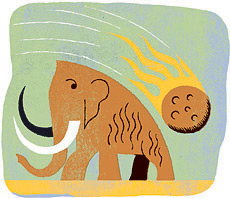
Timothy Cook
Just over 10,000 years ago, some amazing
beasts roamed the planet—wooly mammoths, giant sloths, saber-toothed
cats, camels, lions, tapirs, and the incredible teratorn, a condor with a sixteen-foot
wingspan. Then suddenly they were gone.
In the
September Proceedings of the
National Academy of Sciences , Professor
of Geological Sciences
Peter Schultz
and several colleagues offered new evidence
for the theory that an asteroid
may have been responsible for this mass
extinction. The team analyzed a layer of
the earth’s fossil record and found such
compounds as iridium, charcoal, soot,
carbon spherules, and glass-like carbon
containing nanodiamonds. Schultz
says the nanodiamonds are particularly
meaningful, as they’d form as a result of
the intense pressure you’d get when a
meteorite slams into Earth.

